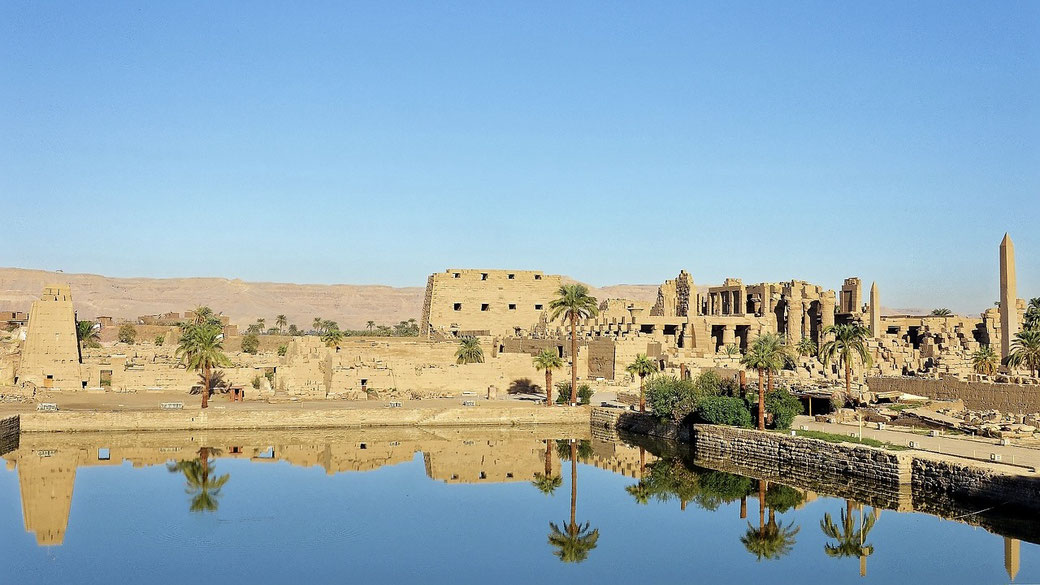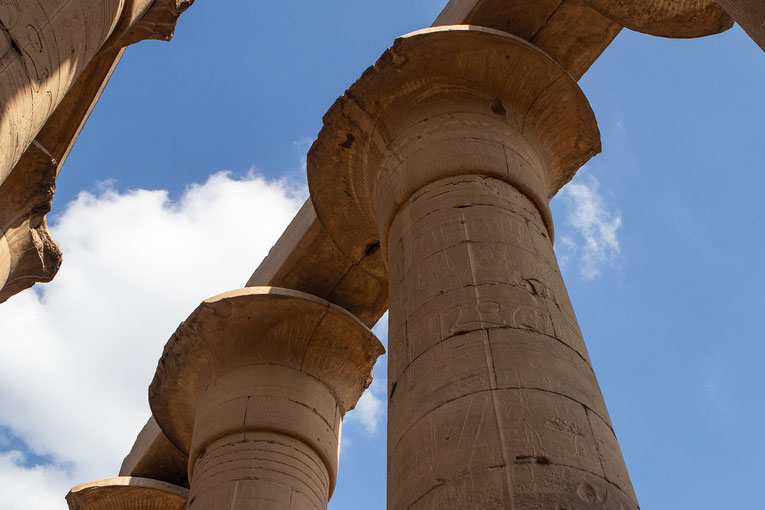The Karnak temple complex: the epicenter of Ancient Egyptian religion and power

The Karnak temple complex is one of the most remarkable and impressive architectural achievements of ancient Egypt. Located near the modern city of Luxor, this vast religious site was built and expanded over a period of more than 1,500 years, from the Middle Kingdom to the Ptolemaic period.
It was the main center of worship for the Theban triad of gods: Amun, Mut, and Khonsu, and attracted pilgrims from all over Egypt and beyond. Today, the temple stands as a testament to the skill and dedication of the ancient Egyptians and is recognized as one of the most significant cultural and historical landmarks in the world.
What was Karnak?
Karnak is a vast ancient Egyptian temple complex located on the east bank of the Nile River in Luxor, Egypt.
It was a place of worship and pilgrimage for over 2,000 years, and was dedicated to the Theban triad of gods: Amun, Mut, and Khonsu.
The complex consists of a series of temples, chapels, pylons, obelisks, and other structures that were built and expanded over time by various pharaohs and rulers of Egypt.
Karnak was not just a temple but a whole religious city that housed priests, officials, and craftsmen who worked on the complex.
The complex covers an area of over 100 hectares, making it one of the largest religious complexes in the world.
It is a testament to the skill, craftsmanship, and religious devotion of the ancient Egyptians, and remains one of the most important historical and archaeological sites in Egypt today.
Who built Karnak?
Karnak was built and expanded over a period of more than 1,500 years by various pharaohs and rulers of Ancient Egypt.
The earliest structures date back to the Middle Kingdom (around 2050 BCE), while the most significant additions were made during the New Kingdom (around 1550–1069 BCE).
Some of the most famous pharaohs who contributed to the construction of Karnak include Senusret I, Hatshepsut, Thutmose III, Amenhotep III, and Ramesses II.
Each pharaoh added their own unique touch to the complex, and over time, the site grew to become one of the largest and most impressive religious centers in the ancient world.
The complex was not built by any one person or in any single period, but rather was the result of a collective effort by many generations of skilled builders, craftsmen, and architects over many centuries.
What are the pylons?
The pylons at Karnak are massive, towering gateways that serve as the entrances to the various parts of the temple complex.
They are characterized by their sloping walls, which rise to a point at the top and are decorated with intricate carvings and reliefs. The pylons were constructed during the New Kingdom period (around 1550–1069 BCE) and were built by several pharaohs, including Hatshepsut, Thutmose III, and Ramesses II.
The pylons were more than just gateways; they were also symbols of the pharaoh's power and authority. The inscriptions and reliefs on the pylons depict scenes from the pharaoh's life, battles, and triumphs, as well as religious themes and the pharaoh's relationship with the gods.
The pylons also served a defensive function, as they were fortified with walls and battlements to protect the temple from invaders.
Today, visitors to Karnak can still see the impressive pylons, which are among the most iconic and recognizable features of the temple complex.

Who was Amun?
Amun was an important god in ancient Egyptian religion, who was revered as the king of the gods and the creator of the universe.
He was often depicted as a man with two wings on his head, or as a ram, and was associated with fertility, creation, and the sun.
Amun was one of the most important gods in the Egyptian pantheon, and his cult was centered at Karnak, where he was worshipped alongside his consort Mut and their son Khonsu in the temple complex's main sanctuary.
During the New Kingdom period (around 1550–1069 BCE), Amun rose to prominence as the primary god of the Egyptian empire, and the pharaohs became known as "the son of Amun," emphasizing the god's central role in the royal ideology.
The cult of Amun continued to be a major force in Egyptian religion until the decline of the pharaonic civilization, and many of the most impressive structures at Karnak were built in honor of this powerful deity.
Key locations within the Karnak complex
The Great Hypostyle Hall: This is the largest hall in the temple complex, covering an area of 5,000 square meters. It is supported by 134 massive columns, some of which are over 20 meters tall, and is decorated with intricate carvings and reliefs.
The Sacred Lake: This is a large rectangular pool located near the center of the temple complex. It was used for ritual purification and was also believed to be the home of the goddess Mut.
The Precinct of Amun: This is the central area of the temple complex, where the main sanctuary of Amun was located. It includes the Great Temple of Amun, the Temple of Khonsu, and the Temple of Mut.
The Avenue of Sphinxes: This is a long, narrow corridor lined with statues of sphinxes that leads from the Precinct of Amun to the Luxor Temple, another important religious site in Luxor.
The Obelisks: The Karnak Temple complex is home to several impressive obelisks, including the tallest surviving ancient obelisk in the world, which was erected by Hatshepsut.

What religious events took place at Karnak?
Karnak was one of the most important religious sites in ancient Egypt, and many festivals and ceremonies were held there throughout the year to honor the gods and ensure the prosperity of the kingdom. Here are some of the key festivals that took place at Karnak:
Opet Festival: This was one of the most important festivals in ancient Egypt, and it was celebrated annually at Karnak.
It lasted for several weeks and involved processions of priests and images of the gods from the Karnak Temple to the Luxor Temple, where the images would spend time in the temple's inner sanctum before being returned to Karnak.
Beautiful Festival of the Valley: This festival was held annually to honor the god Amun and his consort Mut. It involved a procession of the Theban Triad (Amun, Mut, and Khonsu) from Karnak to the Valley of the Kings, where the spirits of the deceased pharaohs were believed to reside.
These festivals, and many others like them, were an important part of life in ancient Egypt and played a central role in the religious beliefs and practices of the people.
The power of the priests of Amun
The priests of Amun were some of the most powerful individuals in ancient Egypt, as the cult of Amun was the most important and wealthiest religious organization in the country.
The priests of Amun were responsible for the worship and maintenance of the temple complex at Karnak, and they wielded significant political and economic influence as a result of their close association with the pharaohs.
During the New Kingdom period (around 1550–1069 BCE), the power of the priests of Amun reached its zenith, and they were able to amass vast wealth and influence over the course of several centuries.
They owned vast tracts of land, controlled vast resources, and were able to dictate the course of Egyptian politics in many ways.
The high priest of Amun, who was the head of the priesthood and the most senior religious figure in Egypt after the pharaoh, was a particularly powerful figure.
He was often a member of the royal family and was closely involved in the affairs of state, advising the pharaoh on matters of politics and diplomacy. He also oversaw the administration of the temple complex at Karnak and had a significant role in the appointment of other high-ranking priests.
The power of the priests of Amun began to decline in the Late Period (around 664–332 BCE), as the authority of the pharaohs weakened and the influence of other religious groups, such as the cults of Isis and Osiris, grew.
What happened to the Temple of Karnak?
However, like many ancient sites, the Karnak temple complex suffered damage over the centuries due to a variety of factors, including natural disasters, invasions, and the wear and tear of time.
In particular, the complex suffered significant damage during the Roman period, when it was looted for building materials and many of its decorations were defaced or destroyed.
In the centuries that followed, the temple complex fell into disrepair, and parts of it were buried under sand and debris. However, in the 19th century, archaeologists began to excavate and restore the site, uncovering many of its hidden treasures and reconstructing some of its key structures.
Today, the Karnak temple complex is one of the most impressive and popular archaeological sites in Egypt, attracting millions of visitors each year.
While it has suffered damage and decay over the centuries, much of its original grandeur and beauty has been restored, allowing visitors to experience the awe-inspiring majesty of ancient Egypt firsthand.
What do you need help with?
Download ready-to-use digital learning resources
Copyright © History Skills 2014-2025.
Contact via email
With the exception of links to external sites, some historical sources and extracts from specific publications, all content on this website is copyrighted by History Skills. This content may not be copied, republished or redistributed without written permission from the website creator. Please use the Contact page to obtain relevant permission.





